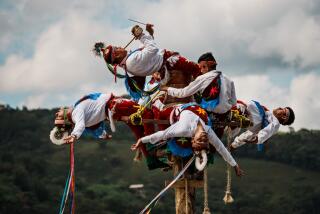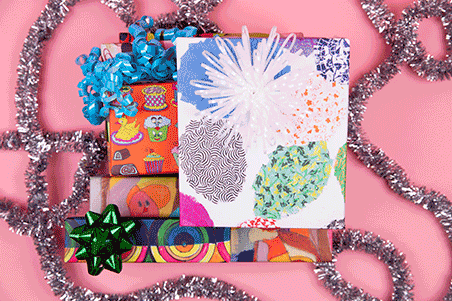A border fence made of air: Native artists to create two-mile balloon installation
The genesis for a two-mile installation that is about to spring up at the U.S.-Mexico border was a cheap balloon intended to scare off birds.
Artist Kade Twist came home one day to find that his wife had ordered a “scare-eye” balloon over the Internet to keep the birds from plundering their fig tree. The yellow, red and black balloons, which feature a circular pattern that mimics the look of a very large eye, can be found on a variety of websites for roughly 10 bucks.
------------
For the record, 6:20 p.m. Sept. 18: An earlier version of this post reported that “Repellent Fence” will run along the U.S.-Mexico border in Arizona. The piece will bisect the border.
------------
Twist says that as a bird scare, the balloons were a failure: “It was party in the backyard everyday when the figs were ripe,” he says.
But the colors and pattern of the balloon caught the artist’s eye. “The iconography on the balloon is indigenous iconography,” he explains. “It’s called an ‘open eye’ and it’s a pattern that used from South America to Canada.... Another thing is the colors. It just so happens that the balloons use Indian medicine colors.”
SIGN UP for the free Essential Arts & Culture newsletter >>
Twist, an enrolled member of the Cherokee Nation, says he was struck by the way this cheap backyard tool employed indigenous aesthetic themes. “It was this really loaded [thing],” he says. “Here’s this consumer object that is laden with meaning and it’s being used to scare away birds — which, traditionally, are considered spiritual mediators.”
Over the years, Twist joked with various artist friends about the possibility of creating some sort of massive installation with the scare-eye balloons. That idea is now set to come to pass.
Next month, Twist and two other artists, Raven Chacon and Cristobal Martinez — known collectively as Postcommodity — will create a two-mile installation that bisects the U.S.-Mexico border, employing the scare-eye balloon in literal and abstract ways.
Titled “Repellent Fence,” the piece will run for four days and will consist of 28 balloons — each 10 feet in diameter — flying at a height of 75 feet at staggered points in Douglas, Ariz., and Agua Prieta, Sonora, in Mexico.
“At that height, both communities will be able to see it from the city and from positions outside the city,” Chacon says. “It’s about the relationship to the land and the sky and the mountains and the metal fence. We’re almost dwarfing the metal fence.”
The piece explores a number of other ideas too. First, the artists aim to reclaim the imagery behind the scare-eye balloon and transform it back into something with deeper significance, one that connects to their indigenous roots. (Chacon is an enrolled member of the Navajo Nation and Martinez is mestizo, of mixed heritage, with Mexican American and some Tewa ancestry.)
Secondly, the project is a way to examine the politics of the border, which has divided Native ethnicities. The Tohono O’odham in Arizona, for example, have members on both the U.S. and Mexico sides of the wall.
“We wanted to reframe the discourse around immigration to acknowledge the indigeneity of the people that are immigrating,” Martinez says. “We wanted to connect it to a long history of immigration in this landscape — we have migrated back and forth on this land since time immemorial.
“And we’re trying to create something intentional between the communities of Douglas and Agua Prieta,” he adds, “something that reminds them what they were before the border wall.”
Postcommodity was founded roughly eight years ago by Twist and a number of other artists. Over the years the group has had a shifting lineup of contributors who work on their own, as well as collectively. (Currently, Postcommodity is composed of Twist, Chacon and Martinez.) The group is known for multimedia installations and performances that explore issues of politics, economics and social issues through an indigenous lens.
They have worked with the scare-eye symbol in the past — suspending a single, oversized balloon over the headquarters of the famous punitive Maricopa County Sheriff Joe Arpaio in 2008.
Even though there’s a big fat border wall there, it’s still possible to perforate it. It’s still possible for people to work together despite the barrier.
— Cristobal Martinez, of the art collective Postcommodity
Like many of their other works, “Repellent Fence” will be more than just a sculptural installation. The piece involves various social and community-minded aspects — such as a symposium on the role of Native American art in social transformation and a cross-border art walk, to be held in the four days that the balloons float over Douglas and Agua Prieta.
Moreover, members of both towns will be involved in inflating and installing the balloons. On the morning of Oct. 9, they will stage a sunrise ceremony to “lift the fence.”
“It becomes a collaboration between the communities,” says Chacon. “On Oct. 12, the balloons will come down in a similar ceremony.” In other words, a piece that explores ideas of division will serve to bring people together.
In fact, part of the reason Postcommodity decided to stage the work in Douglas and Agua Prieta was because the two communities already have a strong cross-border exchange.
“There’s a memorandum of understanding between Agua Prieta and Douglas for binational cooperation and social and economic development,” says Twist. “There is tremendous leadership on both sides there — a lot of generosity going back and forth.”
Even so, the project has required an extraordinary level of coordination — from fabrication to the development of events. For one, the artists, all live in different cities: Twist is in Santa Fe, Chacon in Albuquerque and Martinez in Mesa, Ariz. Together, they’ve spent years working with civic, artistic and business organizations in the U.S. and Mexico to make “Repellent Fence” a reality.
The artists estimate that costs for the project — for the installation and the public programming — have surpassed $200,000. (They’ve covered these expenses with a successful Kickstarter campaign and an array of grants from various organizations, including the Native Arts and Cultures Foundation, the Joan Mitchell Foundation, Art Matters and Creative Capital.)
The team is also at work on a related museum exhibition that will appear at Arizona State University Art Museum in 2017. This will include sound, video and other multimedia elements.
But for now, Postcommodity is focused on what will go down at the border in less than a month — a work that will show that the border isn’t as airtight as some would like to believe. “Even though there’s a big fat border wall there, it’s still possible to perforate it,” says Martinez. “It’s still possible for people to work together despite the barrier.”
The wall may stop people. Ideas, however, are another story.
Postcommodity’s “Repellent Fence” debuts on the U.S.-Mexico border at Douglas/Agua Prieta on Oct. 9 and runs through Oct. 12. For more information, logon to postcommodity.com.
Find me on Twitter @cmonstah.
More to Read
The biggest entertainment stories
Get our big stories about Hollywood, film, television, music, arts, culture and more right in your inbox as soon as they publish.
You may occasionally receive promotional content from the Los Angeles Times.







